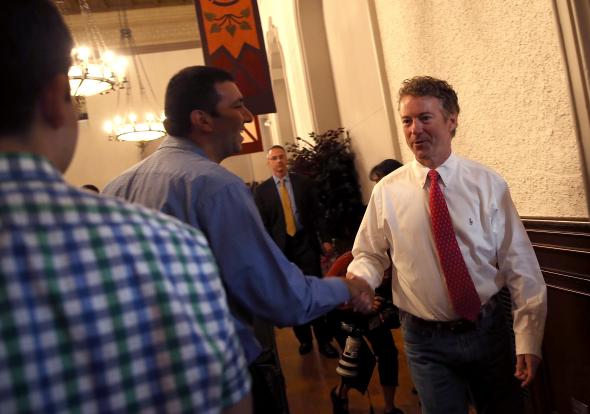Rand Paul’s 2016 Network: Bigger on the Inside

Photo by Justin Sullivan/Getty Images
There's a very meta line about halfway through Robert Costa's look at Rand Paul's 2016 infrastructure. After spending some time describing the reach of Paul's network and the relationships he's built with possible Republican donors—donors who did not necessarily back his father—Costa explains why this is being discussed in March of 2014.
"The decision to swiftly expand and announce Paul’s national political infrastructure," writes Costa, "comes after reports describing Paul’s operation as unready to compete nationally."
That's a winking reference to a buzzy New York Times lead about how Paul's backers wanted more committment from their candidate. The irony: Paul's network has been the strongest of any potential 2016-er since, oh, the day after Romney lost. Costa notes, for example, that "billionaire Peter Thiel" is one of Paul's "top west coast allies." I should hope so, because Thiel plowed $2.6 million into a super PAC that bought ads for Ron Paul in 2012. Costa reports that Nevada's GOP chair and Iowa's outgoing GOP chair are on team Paul, but close observers know they won their jobs with the support of Ron Paul's movement. Costa's story suggests that the elite of the r3volution* are staying with Paul and that he's smartly been courting donors who didn't have a horse for 2016 yet.
Most interesting developments as far as that's concerned: Well, Costa spotlights how Paul's fundraising director, Erika Sather, "a former development director at the Club for Growth, spent much of the winter introducing Paul to donors beyond the rich libertarians" who backed Ron Paul's races.** He also talks to Nate Morris, who's described as a former fundraiser for George W. Bush and a conduit between Paul and the ultra-wealthy.
“The bones for the network are there,” Morris said. “We’ll take that and bring in new talent, people who could be like Spencer Zwick was for Mitt Romney’s on finance. Among donors, there’s a fever out there, people are looking to rebrand the party and they haven’t yet been tapped.”
Still, something worth adding here: Morris is not an old Bush hand. He's just 33 years old. In 2004 he made headlines for being, by far, the "youngest Bush pioneer," a talented and gracious fundraiser who bundled $50,000 for Bush and said he wanted to run for office himself some day.
What's my point? Rand Paul's network absolutely reaches across all 50 states. The spadework of the Campaign for Liberty, created after Ron Paul's 2008 run, created the conditions for Rand Paul to build a new infrastructure based on his own appeal and causes. It's like a mansion built on the bones of a duplex built on the bones of a ranch house. And it wants the press to tour the mansion.
*the r3volution logo, created by Arizona supporters of the 2008 Ron Paul campaign, is a useful shorthand for the people who were there at the beginning.
**Costa refers to them as "the rich libertarians who poured $40 million" into Paul's last campaign, but Paul depended much more on direct mail and small dollar donations. I should probably just go back to the piece I'm writing about this subject.
